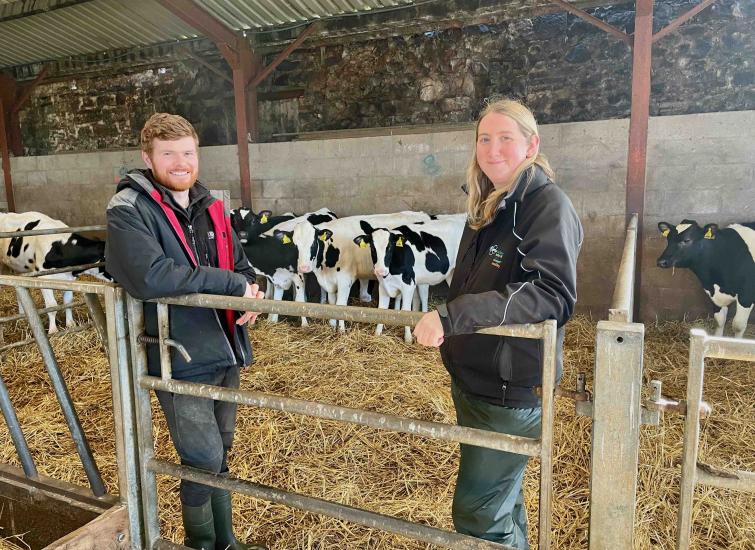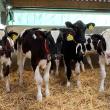Advanced Robot’s experience means they are always challenging me to get the best out of the cows, they maintain the herd’s health status whilst also improving performance.
A Whole-Farm, Data-Driven Approach
Liz Newman, Heifer Rearing Specialist at Advanced Ruminant Nutrition, discusses how this approach can optimise dairy youngstock health, longevity and productivity, using data from Shawsmuir Farm.

In an industry where margins are being squeezed and cow health, welfare and sustainability targets are being raised, our traditional heifer rearing targets need to be re-framed. This is the opinion of Liz Newman and the team at Advanced Ruminant Nutrition. The company promotes a whole farm, data-driven approach to ensure the optimal growth and development of dairy heifers.
Liz Newman explains, “We are constantly being reminded of the importance of daily liveweight gains or hitting specific targets like the average age at first calving (AFC), when heifer rearing. Whilst the research behind these targets proves their importance, there is so much more detail within the data we collect, which can make a big difference. Quite often we find data is not being interpreted correctly and in fact, many need to delve beyond these traditional metrics to be able to identify the most impactful areas on their farm.”
Drawing on benchmarking data from over 200 farms, Liz highlights a substantial opportunity for improvement in heifer rearing practices. “Our analysis of the data we have collected from over 200 farms, reveals the average heifer 305-day yield is 77.2% of an adult cow in the same herd. This suggests that UK heifers are, on average short by 414kg of milk per heifer. On a 200-cow unit, if we were to hit the target of 82%, with a milk price of 38p, this could generate an additional income of £7,866 on heifer milk production.”
Liz explains, “Central to our approach is an individually tailored heifer rearing program designed to ensure every heifer joins the milking herd in peak health, at the optimal age, height and body condition score, capable of yielding 82-85% of the milk of an adult cow in the herd. Heifers should be able to transition smoothly into the milking herd, conceiving at the optimal time, and maintaining robust health well into their third lactation. There is also the expectation to do this in the most cost-effective of ways.”
So, how do they look at things differently?
Falling foul of averages…
Liz continues, “Our findings indicate that relying solely on the 'average' fails to unveil the genuine profitability and productivity of the dairy units we work with. When we examine two Holstein units with an identical AFC of 24 months, for example, variations in their outputs frequently come to light. This is because we need to assess the range in AFC, as well as the farm's feeding and management protocols. This way we can obtain a holistic understanding of the heifer rearing system.”
“DLWG (Daily Live Weight Gain) holds considerable recognition within the industry. While there may be debate regarding a variance of approximately 100 grams, adopting a range of 0.8kg to 1.2kg per day (adjusted according to growth stage), is commonly accepted as a reasonable average. However, it is essential to acknowledge that utilising DLWG as a singular metric lacks holistic insight. We need to recognise that fostering optimal frame growth and facilitating robust rumen development are interconnected and as such should be continually monitored.”
Other key areas that the team focus on in terms of data interrogation include cull rates, tracking drug use, morbidity and mortality cases, and fertility data of maiden heifers. We gather historical data, and continually monitor to benchmark each farm against its own history to ensure improvements. We can also compare farms, to help drive continual improvement and knowledge sharing.
Shawsmuir Farm
The team have been working with Craig Sloan who farms with his father Robert at Shawsmuir in Thornhill, Dumfriesshire. They have 275 Holstein cows, and all replacement heifers are reared themselves on the farm. Familiar with Advanced Ruminant Nutrition’s whole farm approach, having worked with the firm for over 12 years, they were keen to see how it would impact their youngstock, particularly with the use of data from the whole herd.
Liz explains, “This farm was a good example of looking at the average AFC vs. the range. So, whilst the average was 24 months this was spread from 21 to 32 months.
Collaborating closely with the farm team, we worked on some key areas:
- Colostrum management
- Reducing stresses at key points to young calves
- Transition between cows’ milk and powdered milk
- Calf feeding and nutrition plan, with a main aim to reduce health issues and reduce reliance on medication.
- Driving rumen development, to ensure a smooth weaning process
- Driving growth at the most cost-effective points
- Increased protein in the post weaned group to focus on structural growth and mammary development.
- Continued to carefully balance the total mixed ration (TMR) for pre bulling onwards to optimize health and performance.
- Continual assessments of housing, grouping, feeding spaces etc.
Previously, the proportion of heifers calving at over 26 months old stood at 7%, whereas the current figure has reduced to 3.6%. On average, this translates to a difference of two heifers annually from exceeding the target age threshold. Considering an estimated cost of £2.83 (AHDB estimated cost) per day per heifer, this accounts for a potential saving of around £250 per heifer surpassing the target age in this case. This reduction not only results in decreased feed, forage, and straw requirements but also facilitates greater space efficiency and diminishes the prevalence of older, less productive heifers. Furthermore, this improvement correlates with an impressive increase of 537 kg in first lactation milk yield, again proving the importance of drilling down into the AFC data.
By meticulously analysing farm-specific data, identifying areas for improvement, and implementing tailored interventions, farms can optimise heifer health, productivity, and profitability.
Mr Craig Sloan concludes, “Ultimately, it’s the farmer who makes the decisions but we can really benefit from this interrogation of data. It’s reassuring that the Advanced Heifer team are checking and observing the animals on farm and providing useful data from young calves through to the milking herd. This way, we can make the right decisions as a team for the benefit of the business.”
〈 BACK





